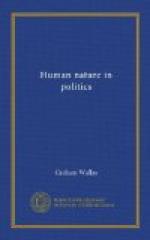In Economics the danger of treating abstract and uniform words as if they were equivalent to abstract and uniform things has now been recognised for the last half century. When this recognition began, it was objected by the followers of the ‘classical’ Political Economy that abstraction was a necessary condition of thought, and that all dangers arising from it would be avoided if we saw clearly what it was that we were doing. Bagehot, who stood at the meeting-point of the old Economics and the new, wrote about 1876:—
’Political Economy ... is an abstract science, just as statics and dynamics are deductive sciences. And in consequence, it deals with an unreal and imaginary subject, ... not with the entire real man as we know him in fact, but with a simpler imaginary man....’[41]
[41] Economic Studies (Longmans, 1895), p. 97.
He goes on to urge that the real and complex man can be depicted by printing on our minds a succession of different imaginary simple men. ‘The maxim of science,’ he says, ’is that of common-sense—simple cases first; begin with seeing how the main force acts when there is as little as possible to impede it, and when you thoroughly comprehend that, add to it in succession the separate effects of each of the encumbering and interfering agencies.’[42]
[42] Ibid., p. 98.
But this process of mental chromolithography, though it is sometimes a good way of learning a science, is not a way of using it; and Bagehot gives no indication how his complex picture of man, formed from successive layers of abstraction, is to be actually employed in forecasting economic results.
When Jevons published his Theory of Political Economy in 1871, it was already widely felt that a simple imaginary man, or even a composite picture made up of a series of different simple imaginary men, although useful in answering examination questions, was of very little use in drafting a Factory Act or arbitrating on a sliding scale of wages. Jevons therefore based his economic method upon the variety and not the uniformity of individual instances. He arranged the hours of labour in a working day, or the units of satisfaction from spending money, on curves of increase and decrease, and employed mathematical methods to indicate the point where one curve, whether representing an imaginary estimate or a record of ascertained facts, would cut the others to the best advantage.
Here was something which corresponded, however roughly, to the process by which practical people arrive at practical and responsible results. A railway manager who wishes to discover the highest rate of charges which his traffic will bear is not interested if he is told that the rate when fixed will have been due to the law that all men seek to obtain wealth with as little effort as possible, modified in its working by men’s unwillingness to break an established business habit. He wants a method which, instead of merely providing him with a verbal ‘explanation’ of what has happened, will enable him to form a quantitative estimate of what under given circumstances will happen. He can, however, and, I believe, now often does, use the Jevonian method to work out definite results in half-pennies and tons from the intersection of plotted curves recording actual statistics of rates and traffic.




